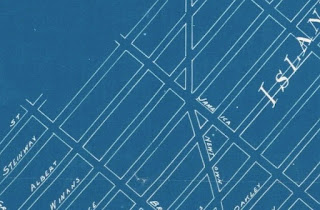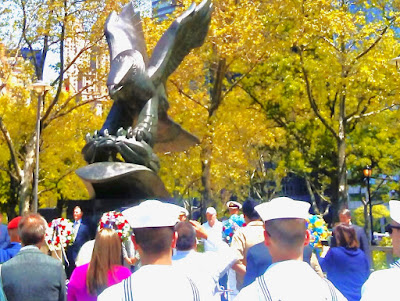William Hallett is oft cited as the first known inhabitant of Astoria, Queens. Learning the truth about his descendants and what may have happened to them has its challenges due to the lack of primary records from that bygone era. After reviewing the various links cited below, I am pleased to share a brief history and context of the first recorded capital crime in Queens County, New York, which took place on January 24, 1707 or 1708. -MCC,ESQ.
Thank you to everyone who has researched and/or written about these parties, and who shared such information, thus making this blog post possible. The two texts that were most helpful in conducting this research and in confirming secondary sources were:
W.W. Mussel & Company. History of Queens County, New York, with illustrations, portraits, & sketches of prominent families and individuals 1663-1882: Press of George Macnamara, 36 Vesey Street, New York, NY, 1882.
The Parties
The William Hallett family is of great historical significance in Queens, especially in Astoria, because William Hallett, sr., was, as mentioned above, the first known inhabitant of Astoria, Queens. In order to place the events pertaining to Queens' 1st capital crime in context, it is necessary to consider three generations of William Halletts. We will refer to them as "William Hallett, sr." for the oldest Hallett, "Captain William Hallett, jr." for the second generation that we are considering in this blog post, and "William Hallett III" as the third generation of Halletts we must consider to make some sense of the events. The records reviewed are generally consistent with this, however, there are some discrepancies.
William Hallett, sen. was one of the 1st sheriffs of Flushing.
William Hallett, sr., in addition to being the father of Astoria, Queens, seems to have been a builder. Records reflect he was a contractor on the 1st court house built in Jamaica, Queens (Mussel p.52, 90). In 1655 his house and plantation near Hell’s Gate, Queens were destroyed by Native Americans (Mussel p.90). Afterwards he moved to Flushing, and in 1656 was appointed sheriff (Mussel p.266, also please see:
https://williamhallett.com/william-hallett-b-1616/). While residing in Flushing he experienced some legal controversies and afterwards, relocated back to Hell’s Gate, Queens and purchased land in a recorded sale in 1664.
In 1688 (Mussel p.267), William Hallett, Sr. divided his property between his sons Capt. William Hallett, jr (b. 1648) and Samuel Hallett (b. 1650), with William receiving the lands “south of the road” which since became Greenoak street, St. George’s place, and Newtown avenue. Samuel Hallett received the lands north of this road.
The names of those streets are no longer in use, but here are two links to a map in the Library of Congress that show the names of the streets as they were then known, when Astoria was part of what was “Newtown, Queens”:
"Map of the town of Newtown, Queens Co., NY, 1896"
However, please note that the map, from 1896, is nevertheless almost two centuries older than the events under consideration. The image below is an excerpt of the maps indicated here.
Capt. William Hallett, jr. was born in 1648 and died in August of 1729. The records reviewed diverge on the exact date in August of his death,(
https://hackerscreek.com/norman/HALLETT.htm,
https://williamhallett.com/william-hallett-b-1616/william-hallett-jr-b-1648/), assuming at least a modicum of accuracy on the part of the genealogies posted online. As previously observed, he is, in some records referred to as "Captain" William Hallett (
http://freepages.rootsweb.com/~stellacotrill/family/william-hallet.htm), as well as "jr." Capt. William Hallet, jr., in 1688 received the property "south of the road" (Newtown avenue) (Mussel p.267), from his father, William Hallett, sr.
Capt. William Hallett, jr.'s brother, Samuel, received the lands north of this road. Thus, according to the historical texts, Capt. William Hallet, jr. was a young child, approximately seven, when his father's home, where the Halletts presumably resided at the time, was destroyed by Native Americans. Capt. William Hallett, jr.'s brother Samuel would have been even younger; perhaps, five years old.
William Hallett III is the subject of the unfortunate events that have drawn the attention of Queens history buffs, Criminal Law historians, and people who are interested in ghost stories (Venn Diagram unavailable).
While reviewing these various sources, it was noted that the name of William Hallett III's wife was denoted variously as Sara, Elizabeth or Ruth. (See for example:
https://www.geni.com/people/William-Hallett/6000000000485194504.) It is fair to conclude that William Hallett III's grandmother was Elizabeth, and his mother was Sarah. The use of Ruth is inconsistent, however, the genealogies note Captain William Hallett, jr. had at some point a wife named Ruth, in addition to William Hallett III's mother Sarah.
The inconsistency of the name of William Hallett III's wife is important not only because she is one of the murder victims, but also because many of the sources reviewed allude to the same original text (Riker) and in that text the name of Mrs. Hallett III is not mentioned on page 142 where the murders are described; Riker merely describes her as Hallett's “fond wife”. It is however, clear that the persons who were murdered were descendants of William Hallett, sr., and that Mrs. Hallett III was pregnant at the time of the murders.
Another important factor to consider is that William Hallett III's and wife's and children's murders are mentioned by at least one of these sources as being the first capital murder case in Queens, New York. I was not able to independently corroborate this, again because many of the persons used the same source materials and the materials themselves were written and published in the 1800s, at least a hundred years after these chilling events took place, and the historical records freely acknowledge that the narratives are conveying facts and circumstances relative to events for which records have been destroyed. Also of note is the fact that none of the genealogical records, nor any of the historical texts identify any of William Hallett III's five murdered children by name. Also, with respect to the records reviewed, the gender of William Hallett III's unidentified murdered five children are unknown. This could be potentially significant, for example, because, generally speaking, the gender of offspring could have an impact on how property was bequeathed.
Before 1670 there was no jail in Queens County (Mussel p.50), instead "criminals were sometimes sent to New York for imprisonment." In 1666 it was ordered that a prison be built in Jamaica, Queens, and a tax was levied on several towns to pay for it. However, by 1669, the court wanted to fine the contractor, William Hallett (sr, presumably), for failing to perform under the contract to build the prison (Mussel p.52). Further, in 1708, the year of the murders and executions the subject of this blog post, the inhabitants of Queens (Mussel p.52 ) petitioned "for the enactment of a law to repair or build anew... the common jail." The historical sources also note that before the 1800s Queens had no district attorney of its own (Mussel p.50), rather, an attorney from New York (county) performed that duty; the office of District Attorney was not created until 1801(Mussel p.54), and with respect to probate of wills, the first surrogate in Queens County was appointed in 1721 (Mussel p.53).
The Murders
“homestead was apparently in a hollow west of ...") From the map that is linked above, we also know that 31st Avenue at that time was known as "Jamaica Avenue" and that this area generally was labelled as "Long Island City" on the map.
Thus according to the sources reviewed, William Hallett III, his pregnant wife and their five children were murdered with an axe "while the victims were asleep" on January 24th, 1708 (Riker p.142), in what was recorded as the first capital crime in Queens County. The crime took place at approximately the intersection of present day 31st Avenue and Newtown Road in western Queens.
According to (
https://williamhallett.com/william-hallett-b-1616/william-hallett-jr-b-1648/) which cites "Abstracts of Wills Vol I 1665-1707, New York Historical Society Collections, 1892, abstracts of wills on file at the Surrogates Office, City of New York, 1665 to 1701" William Hallett III, his pregnant wife, and five children were "barbarously murdered on ye 24th day of January, 1707, by two of his own slaves." Of note is the date discrepancy, with the year of the murders identified as 1707, rather than 1708, which is the year of the murders of William Hallett III and his family, as conveyed by the historical texts.
The date inconsistencies caused me to consult a calendar. According to the calendar consulted, January 24th, 1708 was not a Saturday, it was a Tuesday, and the nearest Saturdays were the 21st or the 28th. However, this inconsistency is addressed when one acknowledges that we now usually use a Gregorian calendar, and Riker is likely using a Julian calendar to convey his dates, in which case, the 24th was indeed a Saturday. This detail is significant because the murders allegedly took place on a Saturday night, according to Riker and Mussel. Around that era, calendars had become misaligned with the moon and sun by as many as 11 days, which prompted a
calendar change in 1752. Although Riker's book was published in 1852, 100 years after the calendar change, he was alluding to events that took place before the adoption of the Gregorian Calendar by the colonies.
However, the fact that the William Hallett website (
https://williamhallett.com/william-hallett-b-1616/william-hallett-jr-b-1648/) is the only example, of all of the materials reviewed, that cites to an actual record from the 1700s (a will) must absolutely be considered. And, according to the part of that document that is quoted, there is no mention of the murders taking place on a Saturday, specifically, as is alleged by Riker and Mussel.
Beyond the details from the links that indicate that the murder weapon was an "axe", utilized while the victims were at home sleeping, the various sources provide no further details of the crimes, for example, whether the victims died immediately or if there was a struggle, the order in which the victims may have been attacked, medical attention they may have received, if any, and whether the murder weapon was recovered and/or in the possession of law enforcement in the aftermath of the crime.
Although the genealogical records cited throughout this blog post reflect some discrepancies, all of the records reviewed reflect that the name of William Hallett III's five murdered children are unknown.
The Punishment
According to Mussel (p.51), on “Feb 2, 1708" "slaves of William Hallett jr., of Newtown" were publicly executed "for the murder of their master, his wife and five children." According to Riker, those publicly executed were a married couple, and it was her idea to kill the Halletts; she allegedly believed Hallett’s property would become her husband's after the Hallett’s demise (Riker P.142-143). Also as per Riker, in an effort to cast suspicion off of herself and her spouse, she went to a neighbor in Hallett's Cove the day after the murders and indicated Hallett and his family had been killed, and that she and her husband had escaped the attack, but then eventually confessed. The identity of the individual(s) in Hallett's Cove to whom she made these utterances is unknown, based on the documents reviewed. The historical texts do not identify Queens' first murderess by name, rather she is identified by her gender ("woman"), her race (Mussel p.51), as a "female fiend" and "guilty creature" (Riker p. 142), and by her status as a "slave."
In addition to the motive described above, another motive ascribed to her was "revenge" for being "restrained for going abroad on the Sabbath." This is interesting for two reasons: 1. It may contemplate the idea that the murders took place on a Saturday night as conveyed by Riker and Mussel and 2. William Hallett sr., who had previously resided in Flushing and was a sheriff there, relocated back to Hell's Gate after a legal controversy: William Hallett, sr. was fined and imprisoned for allowing a Baptist Minister to preach in his house and for "receiving the sacrament of the Lord's Supper from his (the Baptist Minister, Rev. William Wickenden) hands." A quick trip to Wikipedia tells us that
Rev. Wickenden (1614-1671) was "jailed and fined for baptizing Christians in Flushing, Queens."
Thus, throughout the narrative that attends the three generations of Halletts and the persons executed for the murder of the Halletts III, there is an ongoing tension that relates to the family's religious practices, which were clearly, at some point, a source of public controversy.
Since we are talking about dates, now is a good time to consider that Miranda warnings date back to 1966 (
Miranda v. Arizona, 384 U.S. 436 (1966). See:
https://en.wikipedia.org/wiki/Miranda_v._Arizona). Thus there is a 258 year span from the time these gruesome murders, “the first recorded capital crime in Queens County” took place, to the moment when the United States Supreme Court famously addressed the issue of the right against self-incrimination.
Another aspect of this history to note with respect to the dates is the short amount of time that elapsed between the time of the murders, on January 24th, 1708, and the time at which the slaves were put to death, on February 2, 1708. Nine days elapsed between these horrifying events, during which, according to Riker, “the prisoners were arraigned for trial, and being found guilty were executed.” (Riker p.142-143). If the reader chooses to accept instead, that the murders took place in 1707, then this becomes less of an issue. Please note, no transcript of the court proceedings, nor judicial opinion was reviewed for this blog post, and it is unknown to me whether any such records may exist.
If you read Riker, you will see that he describes the punishment of the murderers of Hallett and his family as "torture". She was burned at the stake and he was “hung in gibbets, and placed astride a sharp iron, in which condition he lived some time, and in a state of delirium…”
Now may be an opportune time to mention that:
William Hallett jr. (how he is referred to in the text of The Annals of Newton, In Queens County, New York) was one of 4 men empowered by the Town of Newton to resolve a land/border dispute that had been taking place around that time. The other three men empowered to act on behalf of Newtown, Queens, were Thomas Stevenson, Joseph Sackett, and Sen. Richard Alsop. The land dispute arose around Spring 1706 with a riot that took place on the disputed territory.
The parties to the dispute were:
Newton (Queens County)
As well as:
Flatbush, Brooklyn & Bushwick (King’s County)
Apparently, a survey was conducted during the course of the dispute, without any representation present from Newton, and the survey found 1200 acres of land between Newtown and Bushwick was ungranted, and would thus become the property of the government if the survey could be confirmed. In terms of historical context, the reader should recall that the events we are considering took place before the existence of the United States of America, at a time when Queens was part of an English colony.
On December 27th, 1706 Newtown publicly resolved, apparently referring to then
Governor Cornbury’s Council, which was adjudicating the land dispute, that they were not willing to “leave the above said difference to that board” (Riker p. 141). The dispute continued to move forward, and on September 10th, 1707 there was a hearing at the council chamber, where representatives for Newtown & for the Town of Bushwick (Brooklyn) argued their claims.
Thus, it was amidst the backdrop of this ongoing dispute that William Hallett III, his pregnant wife, and his five children were murdered.
The Native American slave executed via gibbets for the crime was identified in the historical documents as having been named “Sam”. At least two observations may be drawn from this fact: Sam was the spouse of the female slave who was burned at the stake for these murders, and although the idea to commit these crimes was, according to the historical record, hers, she was not identified by name in the records reviewed. Also, "Sam" is similar to William’s relative's name (Samuel), we know this because William sr., divided his property between his two sons, Capt. William jr. and Samuel, and this was apparently recorded (p.267 Mussel).
Eventually, after the murders and executions, the acres subject of the ongoing dispute between parties from Newton and Bushwick, which the survey apparently suggested were undeeded, and thus property of the government, were gifted to Governor Cornbury's friends. However, aspects of the dispute went on for some time, for example, in 1717 a bill was introduced in assembly; “An Act for better ascertaining the division line between King’s and Queen’s County, on the Island of Nassau”.
Going back to 1708, also with respect to the murders, it should be further noted that two additional men were executed as accessories to these murders, several days after the public executions on February 2nd, 1708 (Riker, P. 143, Mussel p.51).
The Hallett Family Cemetery was originally located at what is currently known as Two Coves Community Garden in Queens, New York. The family cemetery was relocated to Mount Olivet in 1905, also in Queens and currently adjacent to All Faiths Cemetery in Middle Village. Before Mount Olivet was a cemetery, it was William Hallett III’s farm (
http://robtutton.com/2013/08/astorias-father-the-relatively-unknown-story-of-william-hallett/#1). However, whether William Hallett III, his pregnant wife and five children who were murdered, were ever interred there, is unclear.
Shifting forward a century and a half from the historical texts, and perhaps to the interest of ghost story aficionados, published accounts of a ghost, dubbed "The White Lady" for her white colonial dress, a few hundred feet from the location of William Hallett III's homestead, have been alleged to be the spirit of the unnamed murdered Mrs. Hallett (
https://qns.com/story/2017/10/12/6-haunted-spots-western-queens/).
Hopefully you have enjoyed the preceding summary of the parties and events involved in the first recorded capital crime in Queens County, New York. While an examination of the historical record of these events may leave us with questions, placing three hundred and eleven years of legal history in context, can hopefully assist in informing the future.
Best wishes for a wonderful summer. 🌆
*In Loving Memory Antonio Pellegrino 1973 - 2000









